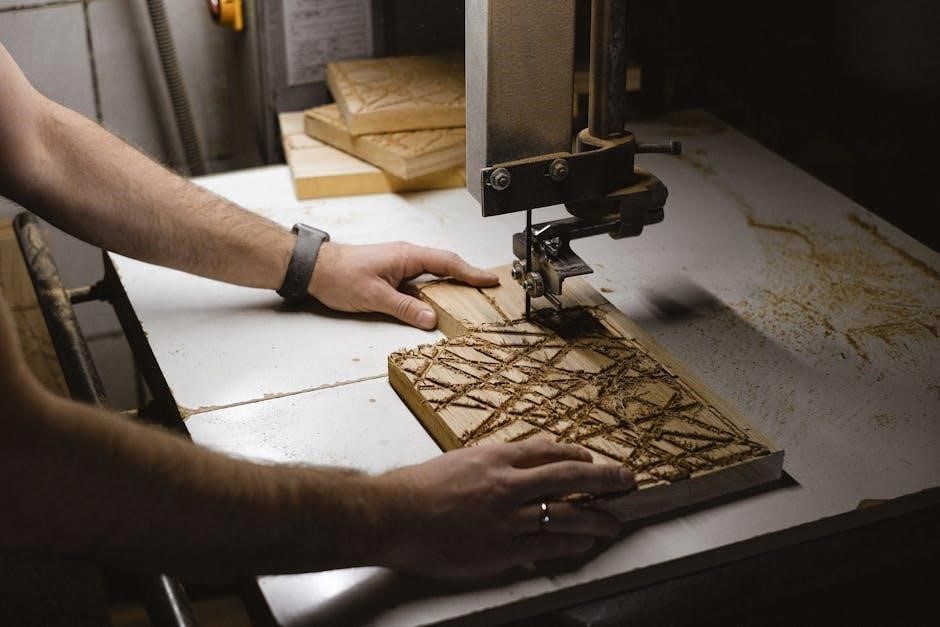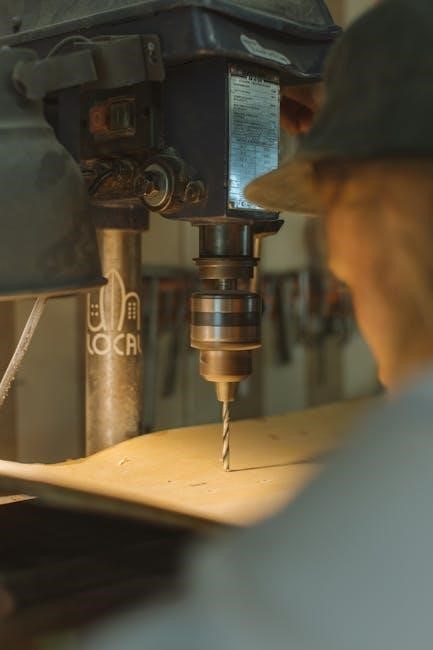The Peddinghaus 510-DGA is a high-precision miter band saw designed for efficient structural steel profiling. Its advanced features and robust construction make it ideal for demanding industrial applications. The PDF manual provides essential guidance for optimal operation, maintenance, and troubleshooting, ensuring users maximize the machine’s capabilities and longevity.
1.1 Overview of the Peddinghaus 510-DGA Model
The Peddinghaus 510-DGA is a robust miter band saw engineered for precision cutting in structural steel applications. Known for its durability and versatility, it accommodates various materials like beams, tubes, and channels. The model features a double miter design, enabling accurate cuts at angles up to 45º and 60º in both directions. Equipped with a servo motor for electric miter swiveling, it ensures smooth and precise angle adjustments. The PDF manual details its operational and maintenance requirements, making it an indispensable resource for users seeking optimal performance and longevity from their investment.
1.2 History and Evolution of Peddinghaus Band Saws
Peddinghaus band saws have a long-standing reputation for innovation and reliability. The 510-DGA model builds on decades of advancements, with early versions like the 2005 DGA 410 and 2006 CNC BDL 1250/9 setting the foundation. Over the years, Peddinghaus refined its designs, integrating servo motor technology and advanced clamping systems. The 510-DGA represents a milestone, offering superior precision and versatility for structural steel profiling. Its evolution reflects the company’s commitment to meeting industrial demands, solidifying its position as a leader in heavy-duty band saw manufacturing.
1.3 Importance of the PDF Manual for Operation and Maintenance
The Peddinghaus 510-DGA PDF manual is a critical resource for operators, providing detailed instructions for safe and efficient operation. It includes guidelines for installation, maintenance, and troubleshooting, ensuring optimal performance. The manual covers essential procedures like blade replacement, lubrication, and calibration, helping users maintain the machine’s accuracy and longevity. Additionally, it outlines safety protocols and best practices, reducing the risk of accidents and equipment damage. By following the manual, users can maximize the saw’s capabilities, ensure compliance with manufacturer recommendations, and extend its operational lifespan.

Key Features of the Peddinghaus 510-DGA Miter Band Saw
The Peddinghaus 510-DGA features electric miter swiveling via a servo motor, a central control panel for easy operation, and a double miter design for versatile cutting angles.
2.1 Miter Cutting Capabilities
The Peddinghaus 510-DGA miter band saw excels in precision miter cutting, offering versatile angles for structural steel profiling. Its double miter design enables accurate cuts at 45º and 60º in both right and left orientations. This feature ensures unmatched precision and consistency, catering to complex cutting requirements. The saw’s ability to handle various angles seamlessly reduces material waste and enhances productivity. With its robust construction and advanced servo motor, the 510-DGA delivers high-accuracy miter cuts, making it a reliable choice for demanding industrial applications.
2.2 Superior Saw Clamping System
The Peddinghaus 510-DGA features a robust saw clamping system designed to ensure precise material alignment and secure holding during cutting. This advanced mechanism minimizes vibrations and slippage, enabling accurate miter cuts. The clamping system is engineered to handle various steel profiles, ensuring consistent performance across different materials. Its durability and reliability make it ideal for high-volume production environments. The clamping system also supports quick setup and material changes, enhancing operational efficiency. This feature is a key contributor to the machine’s reputation for delivering high-quality cuts in structural steel applications.
2.3 Electric Miter Swiveling by Servo Motor
The Peddinghaus 510-DGA features an advanced electric miter swiveling system powered by a high-precision servo motor. This system enables smooth and accurate angle adjustments, allowing for precise miter cuts. The servo motor ensures consistent performance and quick positioning, enhancing productivity in high-volume cutting environments.
With the ability to handle angles from 45º to 60º in both left and right orientations, the servo-driven miter swivel provides unparalleled versatility. Its integration with the central control panel allows for easy programming and operation, making it a standout feature for efficient and accurate structural steel profiling.
2.4 Central and Easy-to-Use Control Panel
The Peddinghaus 510-DGA features a central control panel designed for intuitive operation. This user-friendly interface streamlines workflow, allowing operators to easily adjust settings, monitor cutting progress, and access critical functions. The panel integrates seamlessly with the servo motor for precise miter angle adjustments and provides real-time feedback, enhancing operational efficiency. Its ergonomic design ensures quick access to essential controls, reducing downtime and improving productivity. The control panel is a key element in the machine’s overall performance, making it accessible for operators of all skill levels while maintaining high-precision cutting capabilities.
2.5 Double Miter Design for Versatile Cutting Angles
The Peddinghaus 510-DGA features a double miter design, enabling precise cuts at angles ranging from 45º to 60º in both left and right orientations. This innovative design allows for seamless switching between angles without requiring complex adjustments, ensuring versatility and efficiency in various cutting tasks. The double miter system enhances accuracy and reduces setup time, making it ideal for applications that demand a wide range of cutting angles. This feature is particularly beneficial for structural steel profiling and complex material handling, streamlining production processes and improving overall productivity.

Technical Specifications of the Peddinghaus 510-DGA
The 510-DGA offers precise miter cutting for beams, tubes, and channels, with angles ranging from 45º to 60º. It features a high-performance motor and durable blade design for efficient structural steel profiling.
3.1 Cutting Capabilities for Beams, Tubes, and Channels
The Peddinghaus 510-DGA excels in cutting beams, tubes, and channels with precision and efficiency. It handles materials up to 2″ thickness for beams and 27.6″ for tubes, ensuring versatility. The saw supports cutting angles from 0º to 45º in both left and right orientations, making it ideal for complex structural steel profiling. Its double miter design enables accurate and consistent results across various material types, catering to diverse industrial cutting requirements with ease and reliability.
3.2 Material Handling and Structural Steel Profiling
The Peddinghaus 510-DGA excels in handling various structural steel materials, including beams, tubes, and channels, ensuring precise and efficient cutting. Its robust design allows for smooth profiling of complex shapes, making it ideal for demanding industrial applications. The machine’s capabilities in material handling enable seamless integration with production lines, enhancing workflow efficiency. With its advanced features, the 510-DGA is a reliable solution for high-volume structural steel operations, delivering consistent results and minimizing downtime.
3.3 Blade Specifications and Recommendations

The Peddinghaus 510-DGA requires high-quality blades designed for structural steel profiling. Recommended blades are made from durable materials like bi-metal or carbide-tipped teeth, ensuring precision and longevity. Tooth configurations vary based on material types, with standard ranges of 2–4 teeth per inch for beams and 3–6 teeth per inch for tubes. Proper blade tensioning and alignment are critical to prevent wear and tear. The PDF manual provides detailed guidelines for blade selection, installation, and maintenance to optimize cutting performance and extend blade life. Regular inspection and sharpening are essential for consistent results.
3.4 Motor Power and Performance Ratings
The Peddinghaus 510-DGA is equipped with a powerful motor delivering exceptional performance for heavy-duty cutting tasks. The motor operates at 7.5 HP, ensuring efficient and precise cuts through various materials. Its high torque output enables smooth operation, even when handling large structural steel profiles. The motor’s performance ratings are optimized for continuous use, making it suitable for industrial applications. Proper maintenance, as outlined in the PDF manual, ensures the motor retains its efficiency and longevity, delivering reliable service in demanding production environments.

Installation and Setup Guidelines
- Ensure proper site preparation and leveling before unpacking the machine.
- Follow manual instructions for aligning and securing the saw.
- Connect power and hydraulic systems as per specifications.
- Calibrate the miter angle and blade tension accurately.
- Test the machine with a trial cut before full operation.
4.1 Pre-Installation Requirements
Before installing the Peddinghaus 510-DGA Miter Band Saw, ensure the installation site meets specific criteria. The area must be level, well-ventilated, and free from obstructions. A stable power supply, as specified in the PDF manual, is essential. Proper foundation preparation is required to handle the machine’s weight and vibrations. Ensure adequate space for material handling and operator movement. All safety precautions, including grounding and electrical connections, must be verified. Consulting the manual ensures compliance with manufacturer recommendations for a safe and efficient setup.
4.2 Step-by-Step Installation Process
Begin by unpacking and inspecting the machine for damage. Ensure the installation area is level and meets the manual’s space requirements. Place the saw on a sturdy foundation and secure it with anchor bolts. Connect the power supply according to the manual’s electrical specifications. Install the hydraulic and coolant systems, ensuring proper connections. Perform a test run to check for any leaks or mechanical issues. Finally, calibrate the miter angle and blade tension as outlined in the PDF manual before commencing full operation.
4.3 Alignment and Calibration Procedures
Proper alignment and calibration of the Peddinghaus 510-DGA are crucial for achieving precise cuts and ensuring machine longevity. Begin by verifying the saw’s alignment with the material handling system using a dial indicator to check for deviations. Next, calibrate the servo motor for accurate miter angle adjustments, following the PDF manual guidelines. Ensure the control panel settings match the machine’s operational parameters. Finally, perform a test cut to confirm alignment accuracy and recalibrate as needed. Regular calibration ensures consistent performance and prevents operational errors. Always refer to the manual for detailed calibration steps.

Operating the Peddinghaus 510-DGA Miter Band Saw
Operating the 510-DGA involves starting and stopping the machine, adjusting miter angles for precise cuts, and feeding material smoothly. The central control panel simplifies monitoring and ensures efficient performance.
5.1 Starting and Stopping the Machine
Starting the Peddinghaus 510-DGA involves powering up the machine and initializing the control panel. Ensure all safety precautions are met before operation. Press the start button on the control panel to activate the motor and blade. For stopping, use the emergency stop button if necessary or follow the shutdown sequence in the PDF manual. Always allow the blade to come to a complete stop before leaving the machine unattended. Proper shutdown ensures extended equipment lifespan and prevents potential hazards.
5.2 Adjusting the Miter Angle for Precision Cuts
Adjusting the miter angle on the Peddinghaus 510-DGA ensures precise cuts for various applications. Access the central control panel to input the desired angle, leveraging the servo motor for smooth, electric swiveling. The machine allows for accurate adjustments between 0° to 45° in both left and right orientations. Always confirm the angle alignment with the digital display before cutting. Regular calibration, as outlined in the PDF manual, is crucial to maintain cutting accuracy and prevent errors. Proper alignment ensures consistent results, optimizing productivity and material integrity.
5.3 Feeding Material and Monitoring the Cutting Process
Proper material alignment is critical for accurate cuts. Use the machine’s guide rails to position the material correctly before starting the cut. Monitor the blade’s movement and material feed rate to ensure smooth operation. The central control panel allows real-time tracking of cutting progress. Always maintain a consistent feed rate to prevent blade wear and achieve precise results. Visual inspection during the cutting process helps identify potential issues early. Refer to the PDF manual for specific guidelines on material handling and monitoring techniques to optimize performance and safety.
5.4 Using the Central Control Panel Effectively
The central control panel of the Peddinghaus 510-DGA is designed for intuitive operation, allowing users to streamline cutting processes. It features a user-friendly interface with clear displays for miter angle settings, blade speed, and operational status. Operators can easily program and store frequently used cutting parameters, enhancing efficiency. The panel also provides real-time feedback, enabling precise adjustments during operation. Regularly reviewing the PDF manual ensures familiarity with all functions, optimizing performance and minimizing downtime. Proper training and periodic checks of the control panel are essential for maintaining accuracy and reliability.

Maintenance and Servicing
Regular maintenance ensures optimal performance of the Peddinghaus 510-DGA. Daily tasks include cleaning and lubricating moving parts, while weekly checks focus on blade tension and control panel functionality. Monthly servicing involves thorough inspection of saw components and replacing worn parts as specified in the PDF manual.
6.1 Daily Maintenance Tasks
Daily maintenance ensures the Peddinghaus 510-DGA operates efficiently. Clean debris from the saw blade and cutting area to prevent obstruction. Lubricate moving parts, such as guide arms and bearings, with recommended oils. Inspect the blade for wear and adjust tension as needed. Check the clamping system for proper alignment and tighten any loose components. Refer to the PDF manual for specific lubrication points and schedules. Additionally, verify the control panel functions and ensure all safety features are active. Regularly inspect hydraulic and coolant systems for leaks or blockages. Maintain sharpness of the blade to optimize cutting performance and reduce wear on the machine. Follow the manufacturer’s guidelines for daily checks to ensure longevity and reliability.
6.2 Weekly and Monthly Servicing Recommendations
Weekly servicing involves inspecting the blade for wear and ensuring proper tension. Lubricate all moving parts, including guide arms and bearings, according to the PDF manual. Monthly, clean the saw’s interior and exterior to remove dust and debris. Inspect hydraulic lines and coolant systems for leaks or blockages. Check the motor for optimal performance and ensure all electrical connections are secure. Replace air filters and grease gears as recommended. Review error logs on the control panel and perform alignment checks to maintain precision. These routines ensure the Peddinghaus 510-DGA runs smoothly and extends its operational lifespan.
6.3 Blade Replacement and Sharpening Guidelines
Regular blade replacement and sharpening are critical for maintaining the Peddinghaus 510-DGA’s cutting efficiency. Inspect blades for wear, such as tooth damage or dullness, and replace them when necessary. Use only genuine Peddinghaus blades to ensure compatibility and performance; Sharpening should be done by professionals or using specialized equipment. The PDF manual provides detailed steps for blade removal, installation, and sharpening. Proper tensioning after replacement is essential to prevent blade breakage. Follow the manual’s guidelines to extend blade life and maintain precise cuts.
6.4 Lubrication of Moving Parts
Regular lubrication of moving parts is crucial for maintaining the performance and longevity of the Peddinghaus 510-DGA. The PDF manual recommends using high-quality, machine-specific lubricants to ensure smooth operation. Key areas to lubricate include blade guides, pivot points, and gear mechanisms. Lubrication should be performed every 50 hours of operation or as needed based on usage. Always clean surfaces before applying lubricants to prevent contamination. Proper lubrication reduces friction, prevents overheating, and ensures precise cutting accuracy, aligning with the machine’s maintenance requirements for optimal functionality.

Safety Precautions and Best Practices
Adhering to safety guidelines is crucial when operating the Peddinghaus 510-DGA. Always wear Personal Protective Equipment (PPE) like safety glasses and gloves. Ensure loose clothing is tied back and long hair is secured. Keep the work area clean and well-lit to minimize hazards. Never reach into the saw while it’s operational. Regularly inspect blades and machinery components for damage to prevent accidents. Understanding emergency stop procedures is vital for safe operation.
7.1 General Safety Guidelines for Band Saw Operation
Always adhere to safety guidelines when operating the Peddinghaus 510-DGA. Conduct regular inspections of the saw and blades to ensure proper function. Ensure the work area is clear of debris and obstructions. Properly secure the workpiece before cutting to prevent movement. Never operate the saw without proper training. Keep loose clothing and long hair tied back. Avoid overloading the machine, as this can lead to blade breakage. Use appropriate handling techniques for materials to prevent kickback. Keep emergency stop buttons easily accessible. Follow all manufacturer recommendations for blade installation and maintenance to ensure safe operation. Maintain a safe working environment at all times.
7.2 Personal Protective Equipment (PPE) Requirements
Operating the Peddinghaus 510-DGA requires proper PPE to ensure operator safety. Essential items include safety glasses, hearing protection, and steel-toe boots. Gloves are recommended to prevent hand injuries from sharp edges or moving parts. A face shield is optional but advised for added protection during cutting operations.
The PDF manual emphasizes the importance of using approved PPE that fits correctly. Regularly inspect PPE for damage and store it properly to maintain effectiveness. Adhering to these guidelines ensures a safer working environment and compliance with industry standards.
7.3 Emergency Stop Procedures
In case of an emergency, immediately activate the emergency stop button located on the control panel. This will halt all operations, including blade movement and material feeding. After activating, ensure all personnel are safe and clear from the machine. Do not attempt to restart until the issue is resolved. Regularly test the emergency stop system to ensure proper function. Always refer to the PDF manual for specific instructions and safety protocols. Promptly address any malfunctions to prevent accidents and maintain a safe working environment.
7.4 Safe Handling of Blades and Cutting Materials
Proper handling of blades and cutting materials is crucial for safety and efficiency. Always wear gloves and safety glasses when handling blades to prevent injuries. Use specialized tools to secure and transport blades, avoiding direct contact with sharp edges. Ensure materials are firmly clamped before cutting to maintain stability. Regularly inspect materials for defects or burrs that could cause accidents. Store blades in designated containers to prevent damage and unauthorized access. Follow the PDF manual guidelines for handling specific cutting materials to minimize risks and ensure optimal performance.

Troubleshooting Common Issues
Common issues include blade wear, miter angle inaccuracy, and motor performance problems. The PDF manual provides diagnostic steps and solutions to ensure optimal machine functionality and minimize downtime.
8.1 Diagnosing Blade Wear and Tear
Regular inspection of the blade is crucial to identify wear and tear. Look for worn or chipped teeth, cracks, or uneven wear patterns. Check the blade’s alignment and tension, as misalignment can cause premature wear. Refer to the PDF manual for specific criteria. If the blade shows significant wear, replace it promptly to maintain cutting accuracy and prevent machine damage. Monitoring cut quality and production time can also help detect blade issues early. Always follow the manufacturer’s guidelines for blade inspection and replacement to ensure optimal performance and safety. Regular maintenance extends blade life and machine efficiency.
8.2 Resolving Miter Angle Inaccuracy
Miter angle inaccuracy can occur due to improper calibration or mechanical wear. To resolve this, refer to the PDF manual for recalibration procedures. Ensure the servo motor is functioning correctly and adjust the angle settings as specified. If issues persist, inspect the miter swivel mechanism for wear or misalignment. Lubricate moving parts and verify that all locking mechanisms are secure. Regular maintenance, as outlined in the manual, can prevent such inaccuracies and ensure precise cuts. Always follow safety guidelines when performing adjustments.
8.3 Addressing Motor Performance Issues
Motor performance issues in the Peddinghaus 510-DGA can often be resolved by checking for misalignment or worn components. Ensure proper installation and alignment of the motor. Clean or replace brushes if necessary. Check for loose connections or overloaded circuits. Refer to the PDF manual for troubleshooting steps. Regular lubrication and inspection of moving parts can prevent premature wear. If issues persist, consult a certified technician to diagnose and repair complex problems, ensuring optimal performance and extending the motor’s lifespan.
8.4 Fixing Control Panel Malfunctions
Control panel malfunctions can disrupt operation. First, ensure the power supply is stable and all connections are secure. Check for loose wires or faulty buttons. If the display is unresponsive, restart the machine. For software-related issues, refer to the PDF manual for reset procedures. If problems persist, contact Peddinghaus customer support for technical assistance or replacement parts. Regular maintenance, as outlined in the manual, can prevent such issues, ensuring smooth operation and minimizing downtime.

Warranty and Customer Support
The Peddinghaus 510-DGA comes with a comprehensive warranty, ensuring coverage for parts and labor. Dedicated customer support is available for troubleshooting and maintenance guidance, with options for spare parts and accessories.
9.1 Understanding the Warranty Terms and Conditions
The Peddinghaus 510-DGA is backed by a comprehensive warranty that covers parts and labor for a specified period, typically one year from delivery. The warranty ensures repairs or replacements for defects in materials or workmanship. Exclusions include normal wear and tear, misuse, or failure to follow maintenance guidelines in the PDF manual. Registration is required to activate the warranty, and compliance with specified maintenance schedules is mandatory. Understanding these terms is crucial for maximizing coverage and protecting your investment in the machine.
9.2 Contacting Peddinghaus Customer Support
For any inquiries or assistance with the Peddinghaus 510-DGA, customers can reach out to the dedicated support team. Contact options include phone, email, or through the official website; The PDF manual provides detailed contact information and regional support centers. Ensure to have the machine serial number ready for efficient service. Support is available during business hours, and emergency assistance may be accessible for critical issues. Peddinghaus prides itself on responsive and knowledgeable customer care to address operational, maintenance, or technical concerns effectively.
9.3 Accessing Spare Parts and Accessories
For the Peddinghaus 510-DGA, spare parts and accessories can be sourced directly through authorized dealers or the manufacturer; The PDF manual provides detailed part numbers and descriptions, ensuring accurate ordering. Users can also access an online catalog or contact customer support for assistance. Genuine parts are recommended to maintain performance and warranty validity. Regularly updating or replacing components ensures optimal functionality and extends the machine’s lifespan. Proper documentation and clear communication with suppliers are essential for timely delivery of required items.
The Peddinghaus 510-DGA miter band saw is a high-efficiency tool for structural steel profiling, offering precision and durability. The PDF manual is essential for optimal operation and maintenance.
10.1 Summary of Key Features and Benefits
The Peddinghaus 510-DGA miter band saw excels with its precise miter cutting, superior clamping, and servo motor-driven swiveling. Its double miter design allows versatile angles, while the central control panel ensures ease of operation. Designed for structural steel profiling, it offers efficient material handling and high cutting accuracy. The machine’s robust construction and advanced features make it ideal for industrial applications, providing long-term reliability and productivity. The PDF manual is an invaluable resource for understanding and maximizing these capabilities, ensuring optimal performance and maintenance.
10.2 Final Tips for Optimal Performance
For the Peddinghaus 510-DGA, always follow the PDF manual guidelines to ensure peak performance. Regularly lubricate moving parts and maintain sharp blades for precise cuts. Use the servo motor’s capabilities to adjust angles accurately. Keep the control panel clean and update settings as needed. Proper material handling and alignment are crucial to avoid errors; Schedule routine maintenance and blade replacements to prevent downtime. Finally, ensure operators are well-trained to maximize efficiency and safety while operating the machine.
